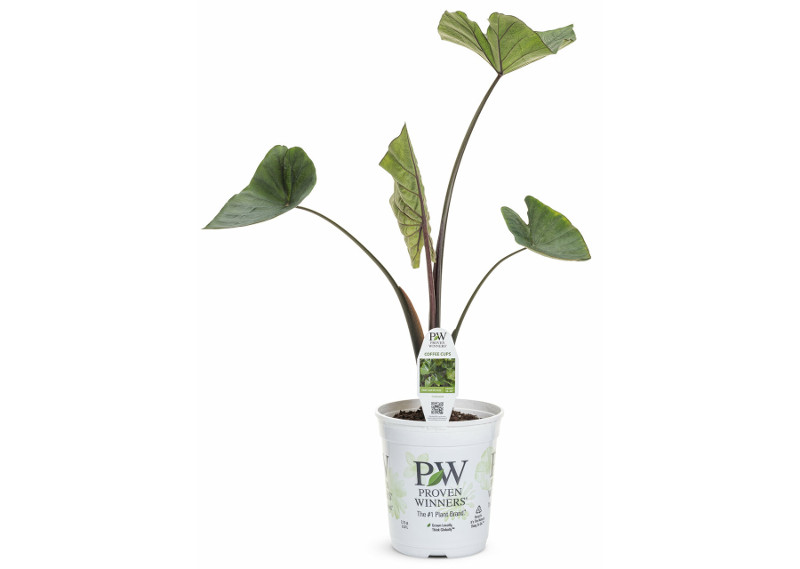The striking foliage of Elephant Ears adds lush greenery and drama to any outdoor space. This statement-making plant can be grown outdoors year-round in USDA zones 9 through 11. In other areas, Elephant Ear plants will need to get out of the elements come fall. The plant can be transplanted into a container for the winter, or the roots can be stored inside and planted back outside in the spring.
For convenience, many gardeners in colder areas opt to keep their Elephant Ears in a container all year. The container can be outside in the summer and brought back inside when the weather turns cold. Elephant Ears are very well suited to growing in pots.

Planting Elephant Ears in Pots
Elephant Ears should be planted in the spring. If you plan to bring your plant inside for the winter, dig it up in the fall before the temperature drops and transplant it into a pot.
Place the container in full sun to part shade. Varieties with green leaves prefer bright sun, while darker foliage varieties will do better with part sun. A mature plant can grow to be up to 6 feet tall. Make sure to select a spot that can accommodate a large plant. The ideal location will also be near a building or structure like a pergola or near trees or other plants. The thin, delicate stems can be damaged in a strong gust of wind, so a somewhat protected area will allow the plant to thrive.
The ideal container will have drainage holes and be 2 inches larger than the root ball, so the plant has space to grow. Terra cotta or ceramic are suitable materials since they are heavier and will anchor the giant plant.
Best Soil For Elephant Ears in Pots
Elephant Ears need rich, well-draining soil. You can amend the soil with manure or compost to help support the rapid growth typical for this plant.
Caring For Elephant Ears in Planters
The level of care needed for Elephant Ears is essentially the same for plants in the ground or a container. Consistent water is mandatory, so check the soil and water when it is slightly damp. Elephant Ears can be grown as a perennial in warmer climates, but in cold climates, the plant will need to be brought inside for the winter. Either plan on transplanting the plant to a pot to bring inside for the winter or leave it in a pot all year so it can easily be moved depending on the season.

Watering Elephant Ears in Pots
Elephant Ears have high water needs, so the plant requires frequent water. Plants grown in containers typically dry out more quickly than plants in the ground; however, the size of the container will impact how quickly the soil dries out. Larger containers, which may be necessary depending on the size of your Elephant Ears, will dry out more slowly. Feeling the earth to determine the dampness is generally the best way to determine how often to water your Elephant Ears.
Fertilizing Elephant Ears in Pots
Feeding a plant helps support growth and allows the plant to bulk up healthily and consistently. Potted Elephant Ears should be fertilized once per month using a 20-20-20 fertilizer. Only fertilize your Elephant Ears when the plant is actively growing. Elephant Ears may go dormant during the winter, even when grown in a container and brought inside. Hold off on fertilizing until the spring if you notice growth stops during the colder months.
Winter Care For Elephant Ears in Pots
Any growth that dies back in the fall or winter can be removed. In USDA zones 9 through 11, the roots can be left in the ground or container and stay outdoors. In all other zones, either dig up the plant and move it to a container to bring inside; or dig up the roots or tubers and store them in a cool, dry place. After the threat of frost, the roots can be planted outdoors, or the container can be moved back outside.
The roots can be planted in a container and kept as a houseplant during the winter. It is normal for the plant to go dormant during the winter and this rest period allows the plant to prepare for the next growing season. If you intend to grow your Elephant Ears as a houseplant during the winter, be patient because the plant may not push out any new growth for 8 to 10 weeks.
Can Elephant Ears Be Grown Indoors
Elephant Ears grow very well indoors. When grown as a houseplant, Elephant Ears require lots of bright indirect light and increased humidity. Try to keep the plant away from heating vents and drafts, and if you notice the leaves drying along the edges, use a humidifier or a pebble tray with water to increase the moisture in the air.
 |
Author Alison Cotsonas - Published 13-12-2021 |
